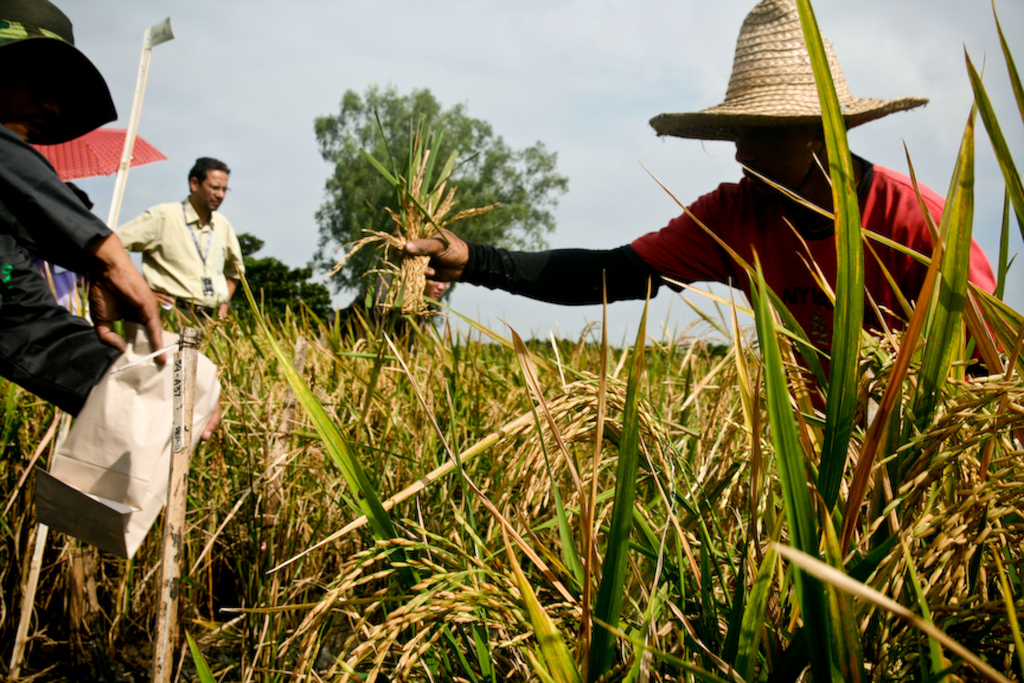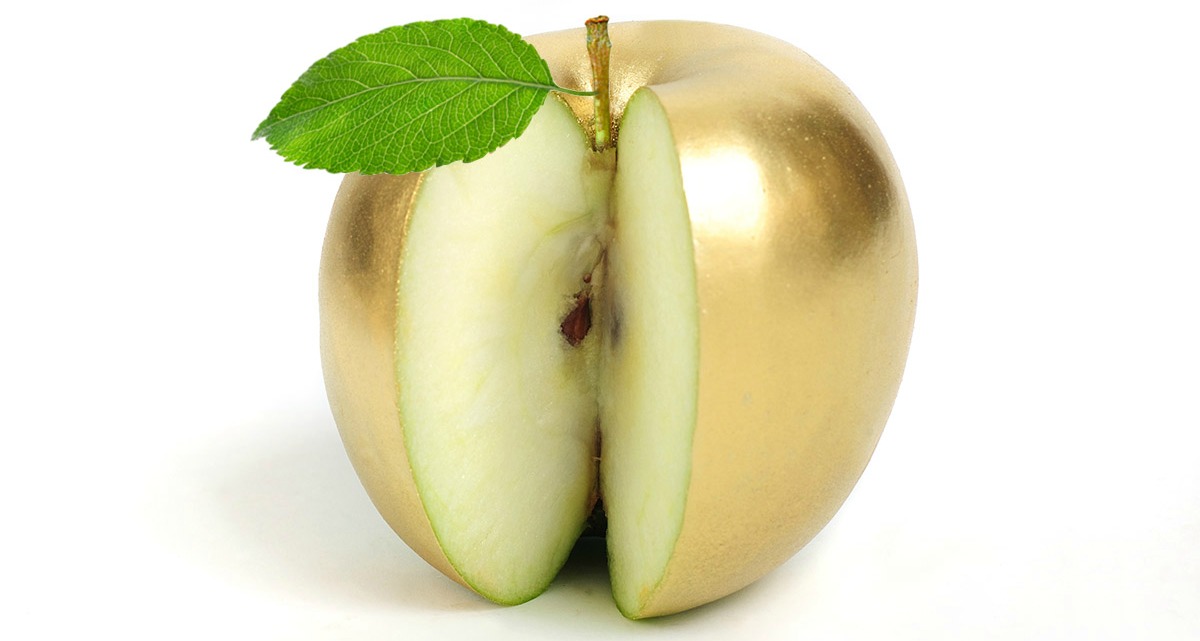Much of the battle over transgenic crops has occurred in the realm of science fiction. There, entirely hypothetical health risks square off against visions of wondrous but imaginary benefits. This isn’t nearly as ridiculous as it sounds: To decide which technologies to pursue and which to avoid, modern Jules Vernes need to dream up best and worst-case scenarios.
The problem is, the debate tends to get stuck in the future. We’ve had transgenic plants for nearly two decades, which is enough time to fairly ask, who has actually benefited from genetically modified crops? We’ve had these plants long enough now that we don’t have to look to fantastic visions of the future; we can simply look at the reality.
In search of reality, I began emailing economists, lawyers, and advocates to ask them this question. The first to answer was Andrew Kimbrell, executive director of the Center for Food Safety. Kimbrell said the companies that bet on GM technology have been its greatest beneficiaries. “The chemical companies, right? The big five: Monsanto, DuPont, Dow, Bayer, and Syngenta … No. 2 would be farmers, specifically big farmers, because it makes their herbicide application a lot easier.”
Farmers pay more to buy the GM seed, and more for the herbicides to treat herbicide-resistant crops, but they save on labor costs. Rather than meticulously spritzing individual weeds by hand to avoid killing the crop, farmers can quickly spray an entire field when using herbicide-resistant plants, Kimbrell said.
Beneficiary No. 3? There is none, according to Kimbrell. “These companies have completely failed, in over 30 years, to come up with a trait that benefits a consumer. Nobody gets up in the morning wanting to buy a genetically engineered food.”
I could think of exceptions: Papaya genetically engineered to resist ringspot virus is more appealing to many consumers than diseased fruit. But these are exceptions that prove the rule; the vast majority of transgenic plants are designed to make farmers, rather than eaters, happy.
What about price? I asked Kimbrell. Do we eaters see lower prices because of genetic modification?
“No. There are no lower prices. GMOs have not lowered prices at all. They have massively increased prices for seed.”
Indeed, seed prices bumped up with the introduction of genetically modified varieties.
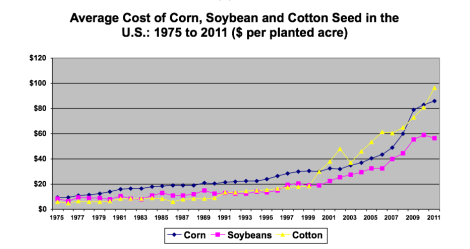
Center for Food SafetyData from USDA Economic Research Service. Click to embiggen.
What about GM crops lifting small farmers out of poverty? Kimbrell scoffed at that. “Smallholders can’t afford to buy [the herbicides] RoundUp and 2,4-D,” he said.
Ask people on opposite sides of this issue if genetic modification benefits the poor and you’ll hear wildly different claims. Kimbrell’s point is that GM crops are designed to save farmers time and money if they are involved in high-tech agriculture. Vandana Shiva, an environmental activist and longtime critic of industrial agriculture, has pointed to cases in which small farmers in India have killed themselves when the debt they’ve taken on to buy seed, fertilizer, and pesticides grows too crushing.
On the other hand, biotech industry consultant Clive James maintains that GM crops are a ladder to prosperity. James has calculated that in 2012, for the first time, farmers in the developing world planted more GM seed than farmers in industrialized nations. These farmers must have a reason for seeking out transgenics.
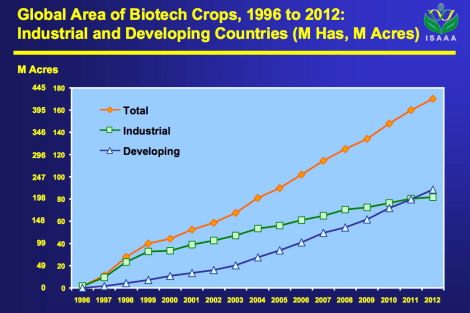
Clive James
Click to embiggen.
As usual in this debate, I find myself stranded between irreconcilable claims. But fortunately, it turns out there’s a large body of economic analyses that have asked precisely the same question I have: Who has benefited?
One of the people I’d emailed, UC Berkeley agricultural economist David Zilberman, sent me a short note from the Ivory Coast suggesting that the benefits of GE food are widespread:
“The seed companies captured less than 50 percent of the economic gains in most studies (frequently less than 30 percent),” he wrote. “The rest [is] distributed between farmers and consumers.”
The studies Zilberman consulted on this question have found that the biotech industry captures between 10 and 70 percent of the money generated by their transgenic seeds. The rest of the benefit (30 to 90 percent) is shared by U.S. farmers, U.S. eaters, and the rest of the world. That’s a huge range, but it’s interesting that every study examining this issue has found that consumers do benefit from food prices. It may not be much — less than 2 percent is the estimate at the lower end — but the average Joe and Jane are probably getting some extra change thanks to GMOs.
OK. Now, what do the economists say about small farmers? Are GM crops lifting them out of poverty or driving them to suicide? A review of the economic publications on this question found that:
During the first decade of their use by smallholder farmers in developing economies, peer-reviewed research has indicated that, on average, transgenic crops do provide economic advantages for adopting farmers.
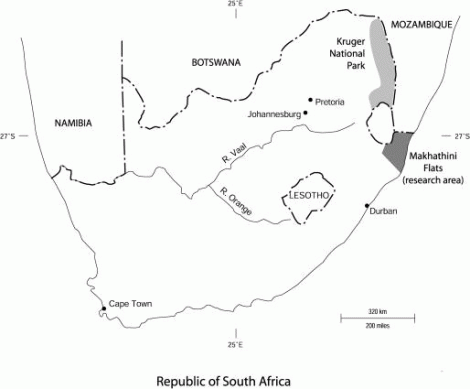
Makhathini Flats.
But hold on: That average hides all sorts of highs and lows. I love this review, done by the International Food Policy Research Institute, because the authors carefully noted the problems with each analysis. For instance one study, following the introduction of GM cotton to the Makhathini Flats in South Africa, found that small farmers were major beneficiaries of the technology. But another, more thorough, analysis suggested something more complex: Small farmers had made a little more money with the transgenic cotton, but only because the Vunisa Cotton company had set them up for success.
Vunisa pitched the transgenic seed to farmers; supplied them with pesticides, fertilizer, loans, and advisors; and then bought up all their cotton. Farmers are vulnerable when they can only buy from, and sell to, one company. That company can ratchet up the cost of seed, while ratcheting down the amount it pays for cotton. So in the Makhathini Flats, farmers were making a little more money — at least for the first few years — but they were also in a much more precarious position.
And this example is part of a theme. In general, GM crops do seem to give small farmers an economic boost, but the studies rarely look at the bigger political and economic tradeoffs those farmers are making. Those tradeoffs do sometimes have dire consequences — like farmer suicide.
But it doesn’t look like the introduction of GM crops is responsible for a large percentage of those deaths. Check out this graph from Nature:
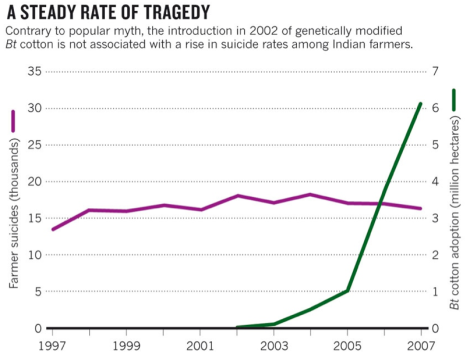
The sad fact is that a lot of farmers kill themselves in India. The numbers didn’t budge significantly with the introduction of GM plants. There are, however, many well-documented cases in which debt — in part from the purchase of GM seeds — drove farmers to suicide. That’s absolutely true. It’s more accurate to say that suicides are caused by the bigger economic monster: The system that requires farmers to take on extravagant debt to compete.
A small farmer who owns his land and saves his seeds each year is relatively independent. A farmer who must take out loans to buy GM seeds, fertilizer, irrigation equipment, and pesticides is beholden and making a riskier (though also potentially more lucrative) bet. For each technological innovation, farmers trade some of their independence for a shot at greater profit. Perhaps it’s fair to say GM seeds are a synecdoche — a part that represents the whole — for the larger system that’s causing farmer suicide in India, especially in those areas where the only seed available to farmers is genetically modified.
So who has made money from GM technology? Seed and chemical companies, for sure. Big farmers, too. Little farmers have gained less, and have had to trade away more privileges. And the rest of us probably pay a little less for GMO food (industrial meat, for example). And all of this is a little fuzzy, because economics is an inexact science, and the studies are still coming in.
The question of who benefits goes beyond money, of course. We also need to look at the environment: Some see GM crops as an environmental savior, while other say they are a disaster. I’m going to make my usual kamikaze run into this minefield to see if there’s any way to reconcile the evidence each side presents.
Before I do that, though, I’m going to talk to some farmers and learn what the pluses and minuses look like from their perspective. Do farmers feel they are trading away intangibles for each new technological advancement?
More in this series:
- The genetically modified food debate: Where do we begin?
- The GM safety dance: What’s rule and what’s real
- Genetic engineering vs. natural breeding: What’s the difference?
- Is nature a cradle or a battlefield?
- Genetically engineered food: Allergic to regulations?
- Genetically modified seed research: What’s locked and what isn’t
- Genetically modified literature (in which I read books so you don’t have to)
- Is extremism in defense of GM food a vice?
- Elephant in the room: Why getting the GMO story straight is so hard
- Food for bots: Distinguishing the novel from the knee-jerk in the GMO debate
- Pointed talk: Michael Pollan and Amy Harmon dissect a GM controversy
- Golden Rice: Fool’s gold or golden opportunity?
- Food, fatherhood, & fear: Documentary wades into GMO debate with honest emotions
